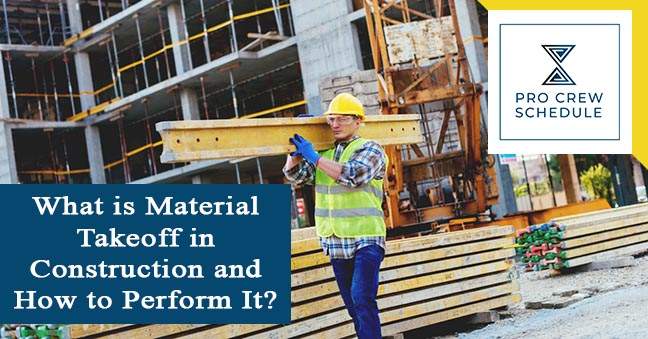When you belong in construction, you are most likely familiar with the terms construction takeoff, the material takes off, or simply takeoff. Whether you are a contractor, subcontractor, or estimator, it is crucial for you to understand what material takeoff is and how to perform it. This ensures you a proper estimation of the requirements and costs for all the materials.
Read this blog to learn more about construction material takeoffs and how to perform one, how they are different from estimates, and some of the best tactics to enhance construction material takeoffs.
What is Material Takeoff in Construction?
In construction, the process that every contractor uses to determine the exact quantity of all the materials needed for a particular project is called takeoff. This construction takeoff is a crucial step in producing accurate estimates for the costs of the construction project.
A takeoff can be done by hand or using construction scheduling software, but it is important to get a precise count of materials even before submitting a bid. Otherwise, you can be stuck overpaying for those materials and cut off your profit. You do not want that to happen, do you? Another thing worth noting is the difference between material takeoff and estimates, which we will discuss below.
Material Takeoff vs. Estimates
When it comes to takeoff, it specifically pertains to the coming up with the number of materials being required for the project. That is why the process is commonly called “Material Takeoff”. In other words, an estimate uses the takeoff quantities and current material prices to figure out the total costs of the required materials.
While others use the word takeoff to refer to the entire process of creating an estimate, generally speaking, you can always think of this as two different and separate processes.
- First, estimators conduct a material takeoff to get a precise list of the exact quantities and items necessary for the project.
- Second, estimators create an estimate by figuring out present materials pricing and calculating other costs, like equipment, labor, and travel.
Though these two processes are nearly related, ultimately, the most important goal of the takeoff is to make sure a precise count of materials. With that being said, the overall takeoff process becomes closely associated with the estimating process due to the extensive use of project management software.
How to Perform a Material Takeoff?
Creating a comprehensive list of the exact quantities of all materials necessary for the project is the ultimate goal of the material takeoff. The term takeoff directly comes from the process of counting by hand, where a contractor will takeoff items one by one from the construction drawing and record them in the list.
So, whether you perform a takeoff by hand or you are using construction project software, the basic process is the same:
- Itemize the necessary materials: You should create a list of all the items necessary for your project or the materials needed for the particular trade.
- Consult the construction documents: By properly referencing the specifications and blueprints, you can see which type of materials has been requested.
- Calculate quantities: You must methodically work through the drawings and take off every item from the drawings as you add it to the list of quantities.
Most importantly, if you are assigned to perform the takeoff, you need to ensure that every item required to complete the buildings is quantified and listed. While the process itself is very straightforward, one critical aspect is that you need to record different accounts of materials in many ways. For example:
- By area: Drywall, sheathing, flooring, and other similar items are being calculated by the square foot.
- · By count: Individual items such as standard wall studs, outlets, light fixtures, doors, windows, and other similar items are simply counted.
- By volume: Sand, gravel, concrete, and other similar items should be calculated by the cubic yard or cubic foot.
- By length: Conduit, lumber, ductwork, wire, and other similar items are commonly listed by the linear yard or linear foot.
Furthermore, every trade will have specific items and materials crucial to quantify while performing the takeoff. A precise takeoff will help you and your subs create a better estimate and properly bid on your upcoming projects.
Improve Material Takeoffs with These Eight Tips
Let us take below eight leading tactics that can enhance construction material takeoffs:
1. Reduce Manual processes
The way you input data for material takeoffs can be a potential barrier to efficiency. When you opt for excel templates and spreadsheets for calculating quantity takeoffs, there can be a rising increase in human errors. Automation can help you eliminate the time-wasting back-office processes involved in the process.
If the material takeoffs are being optimized with automation, the process is more calculated and accurate in a fraction of the time. Only the right software construction management can help you achieve optimization with your construction takeoffs. With this software in place, you can make adjustments as much as possible.
2. Use a Master Checklist
The number one piece of advice we can give you is to use a master checklist. Having one can help you track and account for any potential item included in a typical takeoff. One leading cause of cost overruns in your projects is probably the omissions. And it is one of the things you should pay attention to in your checklist. More than anything, update the master checklist regularly to account for all items you have missed in the past.
3. Prepare for any Worst-case scenarios
The cost of construction materials is consistently on the rise. Materials tend to fluctuate due to many circumstances right now. Take also into account the high costs of construction waste. The costs of construction waste right now include unexpected expenses like storage, tracking, and recycling for managing construction waste.
By determining the factors with the higher risks for material rises early on, you can always prepare for the worst-case scenario more accurately.
4. Double check your numbers
And since construction takeoffs involve a lot of specific measurements and different types of materials, it is crucial to be sure that your calculations and numbers are solid. In order to do this, try running through all your calculations with a lot of timers to make sure you did not skip over the materials or mistake a calculation.
5. Use Building Information Modeling
BIM is another way to create a more precise material takeoff. This intelligent 3D model-based process can give every construction professional the tools and insights to more efficiently design, plan, and construct buildings and infrastructures.
Using BIM to prepare for construction takeoffs can make your planning process more efficient, with the most precise specification and visual data from your construction projects. Moreover, your team can better address alterations and changes rather than calling last minute, resulting in costly changes.
6. Optimize Workflows
Construction projects, in particular, are most likely to have more takeoffs due to the project scope. Thus, it is crucial for you to make improvements to your material takeoff workflows before scaling up everything. Collaborative project management software is critical in this process. When you deploy cloud-based software tools to manage your takeoffs, everyone in your team is able to work and communicate within the digital space.
With the use of the cloud-based platform, saving information is easier. A cutting-edge software like this truly speeds up the time and can make changes with less chance of errors.
7. Anticipate changes
When completing your material takeoff, always remember that the changes may occur in the project that often require adjustments due to the number of materials. These changes may occur from alterations of the blueprints or sometimes even from unforeseen circumstances onsite like harsh weather conditions.
It is beneficial to keep your original takeoffs accessible throughout the project to adjust them when necessary.
8. Prioritize Integrations
If not properly incorporated into other construction tools and processes, there is a much greater risk of losing critical data from the takeoffs. Make it your goal to include your material takeoffs into as many construction processes as possible. Begin by using the most successful construction techs, like cloud-based scheduling software and BIM models.
Always choose the right construction takeoff solution to integrate your current systems and platform.
Ensure Material Takeoffs are Done Right with Pro Crew Schedule
Today’s latest construction technologies modernized many aspects of the construction sector, and takeoffs are no exception. With the use of the best construction management software like Pro Crew Schedule, the speed and accuracy of performing takeoffs will skyrocket. In particular, this software tool enables you to load track construction drawings, files, and documents. It has amazing features where you and your team can count and itemize the current required materials.
Pro Crew Schedule is an all-in-one platform where you can point, click, and drag collective information off to the project plans rather than manually calculating measurements and quantities – a particular method that is prone to many errors.
Get started with a 30-day trial for FREE and experience all of its amazing features!
Key Takeaways
While the takeoff is not the most amazing part of a project, it is still one of the most important. Contractors should make the best possible construction takeoff so that they can finish on time, within the budget, and gain healthy profit margins.







